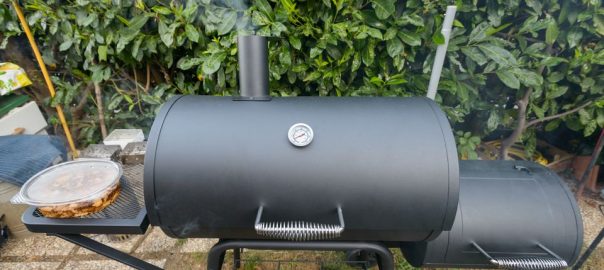
Smoke Amazing Meat: Low and Slow Barbecue
Low and Slow: How to Cook Amazing Meat in a Smoker
Life whips by at light speed these days, and somehow this need for haste has insinuated itself into the way we cook and eat. Even when we attempt to get back to our ancient roots and cook over a live fire, we resort too often to the blistering heat of the propane grill.
But meat tastes better when we slow down and cook it over low heat. The way they did it in the paleo days. While early man seared off small strips of meat for immediate gratification, they slow cooked the bigger chunks. This allowed the connective tissue in tougher cuts time to break down and release their savoury flavours. It also helped preserve the leftovers, the invention of the Frigidaire still a long time coming.
Primitive man honed and refined these techniques for centuries. Millennia, even. This cooking style can still be found in places like Mexico and Hawaii where it’s not uncommon to slow roast whole pigs in smoky underground fire pits. And this same spirit lives on today in backyards across North America as people eager for a deeper connection to the food they consume rediscover the joys of barbecuing the old way; low and slow.
If you want to join the ranks of backyard pit masters but don’t know where to begin, read on. We’ll have you up and running in no time. Because as far as barbecue’s concerned, it’s never too late to take up smoking.
A brief history of American barbecue
What we often think of as American barbecue predates the arrival of Europeans on these shores. Early explorers like de Soto and even Columbus recounted meals of barbacoa prepared by their indigenous hosts, the meat cooked slowly over indirect heat.
As settlements took root in the South, pigs ran wild in the forests, their meat becoming lean and tough. But people hunting these pigs soon figured out that low and slow cooking made the pork palatable.
Today, barbecue has evolved into a tradition with four major geographic styles; Kansas City, Memphis, Texas, and Carolina. KC is known for its sweet sauces that can easily burn if cooked too hot. Memphis sauces are thinner and tangier. In Texas, it’s primarily about the beef. But in the Carolinas, the meat of choice is pork—shoulder, ribs, or whole hog.
Wood—what to look for
Low and slow barbecue distinctively relies on cooking with wood. Real burning wood. A propane flame won’t cut it here. You may as well try to make pulled pork in a microwave.
Real barbecue cooks over the most primitive fire possible. Most smokers on the market work with a mix of lump charcoal—already burned up wood—and chunks of dried wood. Hard wood, too. Woods, like alder, apple, cherry, hickory, maple, mesquite, oak, and pecan.
It can’t be stressed enough. Hard wood makes a cleaner flame. The resins in softer woods can leave a bitter aftertaste—and sometimes, toxins. Resist the temptation to use deadfall from softwood trees on your property like pine and cedar.
If you don’t have a hardwood orchard on your property, you can buy prepackaged bundles of wood from barbecue stores. And since each tree imparts a unique flavour to the meat, using packaged wood lets you enjoy the taste of non-native species when you smoke at home.
Conversely, you could check around with local farmers to see if they sell wood from their orchards. It’s a great way to put a local spin on recipes adapted from other regions. Put a Canadian twist on Memphis barbecue by smoking with maple. You won’t regret it.
And if you get caught up in the whole-chips-versus-chunks debate and whether you should soak your wood, follow this advice: chips only go on the grill (more on this later) and chunks shouldn’t be soaked. Why not? Because hardwood doesn’t absorb water. That’s why they build boats out of it. Trying to soak it wastes valuable time.
The other kind of smoke rings
Another thing unique to smoking meat is the smoke ring, a pinky layer of flesh where the smoke literally changes the colour of the meat. Barbecue newbies sometimes panic when they notice their eating pink meat, especially if it’s chicken. But the meat’s not raw, it’s just smoked.
When meat is raw, it’s the meat on the inside you need to worry about. If your drumstick is pink around the bone, beware. But if the pink meat wraps around the outside, that’s a smoke ring.
As Steve Raichlen explains, burning wood creates nitrogen dioxide gas. This gas binds with the surface of the meat, penetrating in a few millimeters, too. And this bonding creates myoglobin, giving the meat that distinctive pink hue.
Some barbecue bosses pride themselves on the depth of their smoke rings, and even resort to cheating to enhance them. But if you don’t get rings on your first few cooks, don’t worry. You can make great tasting barbecue without them.
More art than science
Like many things these days, many people over-complicate smoking with gadgetry. But the guy who cooked for Columbus didn’t have any thingamajigs, gizmos, or doodads. The whole idea of smoking is to keep it primitive.
To do it right, you’ll need:
- a cooker (see below)
- a water pan to keep the cooking environment humid, and
- maybe a drip pan
although sometimes the water pan serves double duty catching drips.
You’ll need a small, relatively cool fire, usually between 250–275°F (120–135°F). And that heat needs to be consistent. Don’t let the fire die!
Also, keep an eye on the smoke itself. Wood smoke basically falls into two categories; thin, blue smoke and thick, white smoke. You want thin and blue. Thick and white can have an acrid aftertaste. But the smoke will get thicker and whiter when you refuel the fire. There’s no winning, sometimes. Ideally, the smoke is almost invisible, showing itself only in a shimmer of heat distortion around your smoker’s vent.
And try to resist the temptation to check in on your meat too often. You loose heat every time you open the lid. If you absolutely must know the doneness of your meat, see if your barbecue store has a remote thermometer. The new ones even have phone apps, so your cook can be high tech and primitive at the same time!
Health concerns! What health concerns?
Some data suggest eating smoked food leads to intestinal cancer. But this was just one study involving a small sample group in Hungary. Why is that important? Because the laws regarding smoked food are very different there, and the concentration of contaminants is roughly eight times higher there than in North America.
Smoking has also been linked to promoting the growth of Listeria bacteria. And even though it rhymes, it can be serious, especially when passed from mother to unborn child. However, this primarily pertains to cold smoking, such as the curing of sausages and ham. Smoking over a live fire in a smoker will get the meat warm enough to neutralize all bacteria.
Types of smokers
You can make a smoker out of almost anything metal—from old oil drums to wood stoves—if you can weld. Barring that, there are also several commercial options.
- Converting a propane grill: many propane grills get way too hot to consider as smokers. But if your grill can cook at low heat, try turning the gas off on one side. Put a drip pan under the grate on the cold side. Otherwise, you could have a nasty grease fire on your hands when you try using the grill in its standard configuration again. Over the heat, fill a smoker box with soaked wood chips (and don’t use them anywhere else). The meat goes on the cold side, over the drip pan. A foil lasagna pan works well for this. Keep the lid closed. This method isn’t great, but it beats adding liquid smoke to a slow cooker.
- Converting a kettle grill: To smoke on a classic kettle grill, put a drip pan full of water to one side under the grate. On the other side, bank a small pile of burning charcoal and wood chunks. Again, the meat goes over the pan.
- Bullet smokers: Units like the Weber Smokey Mountain put everything you need in a convenient vertical stack. The fire burns under the water/drip pan and two racks of meat cook above. A great entry level smoker for someone looking for a dedicated device.
- Offset smokers: An offset resembles an oil drum laid sideways. With a fire box to one side, some of the heat naturally escapes, keeping things from getting too hot.
- Cabinet smokers: These units look like old filing cabinets and can be powered by propane or electricity heating pellets of compressed sawdust. Many cabinets can also do cold smoking. These smokers tend to require less oversight as well.
- Pellet smokers: The ultimate in set-it-and-forget-it smoker technology, auger-fed pellet smokers do a lot of the work for you. Sure, this limits your craftsmanship. But there’s a perfect brisket waiting for you at the end of the day, which helps reduce the sting.
Slow down and enjoy your food
Discovering the joys of low and slow live fire cooking makes life go at a more dignified pace. Smoking frowns upon speed demons. It demands concentration, mindfulness, and—above all—patience. Plus, a certain degree of humility.
If these facets have been lacking from your life lately, some time in the yard turning food into art could work wonders.
Need a hand keeping that barbecue low carb?
What’s the great thing about smoking meat? It’s pretty much no carb. Even if you’re doing pulled pork, there’s no law saying it has to be a sandwich. But when in doubt, we’ve also put together a convenient guide for keeping your barbecue low carb.
And if you’re smoking meats, you will need spice rubs. Some blends can have hidden carbs, though. But have no fear, we’ve got you covered.






